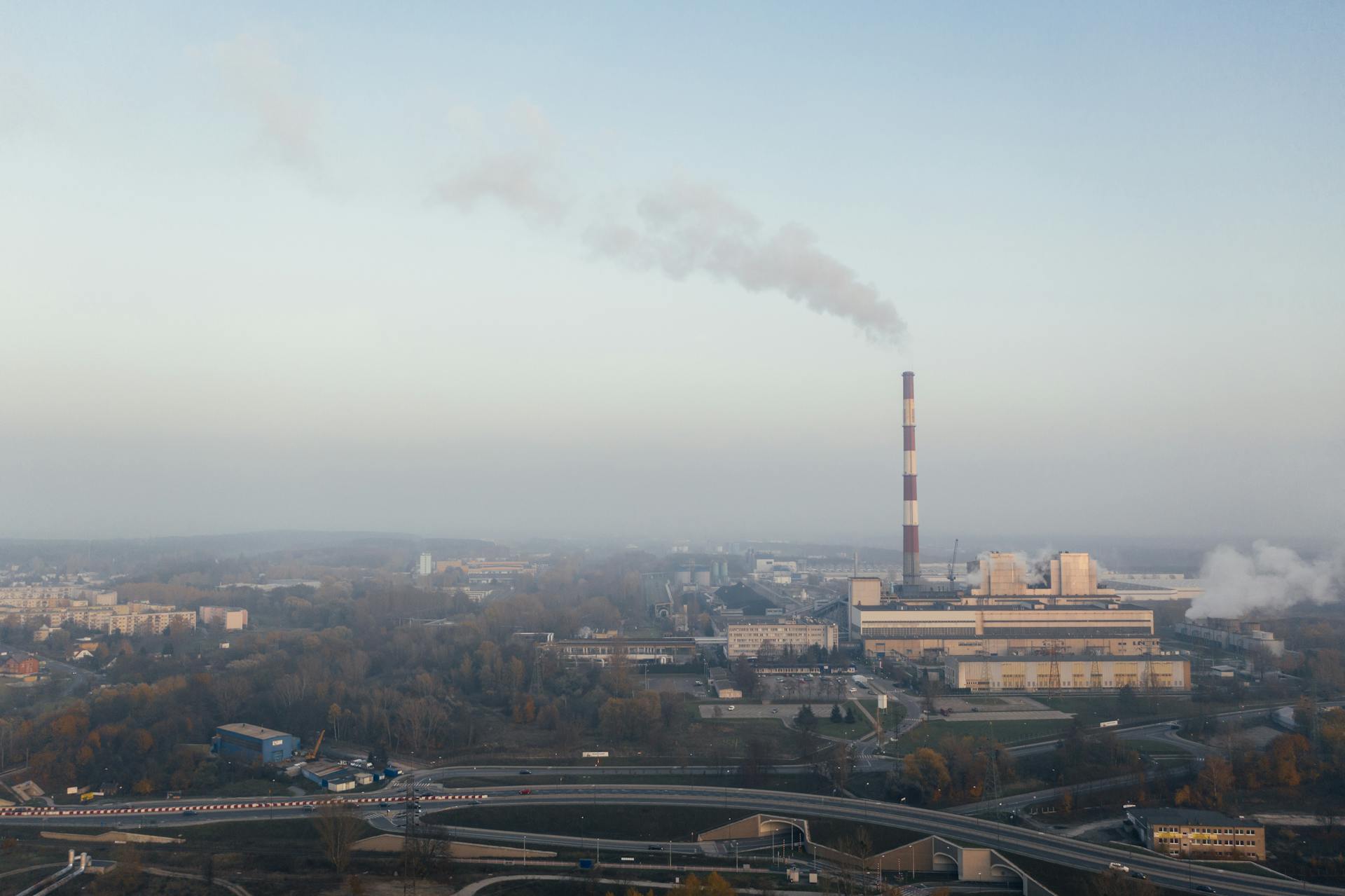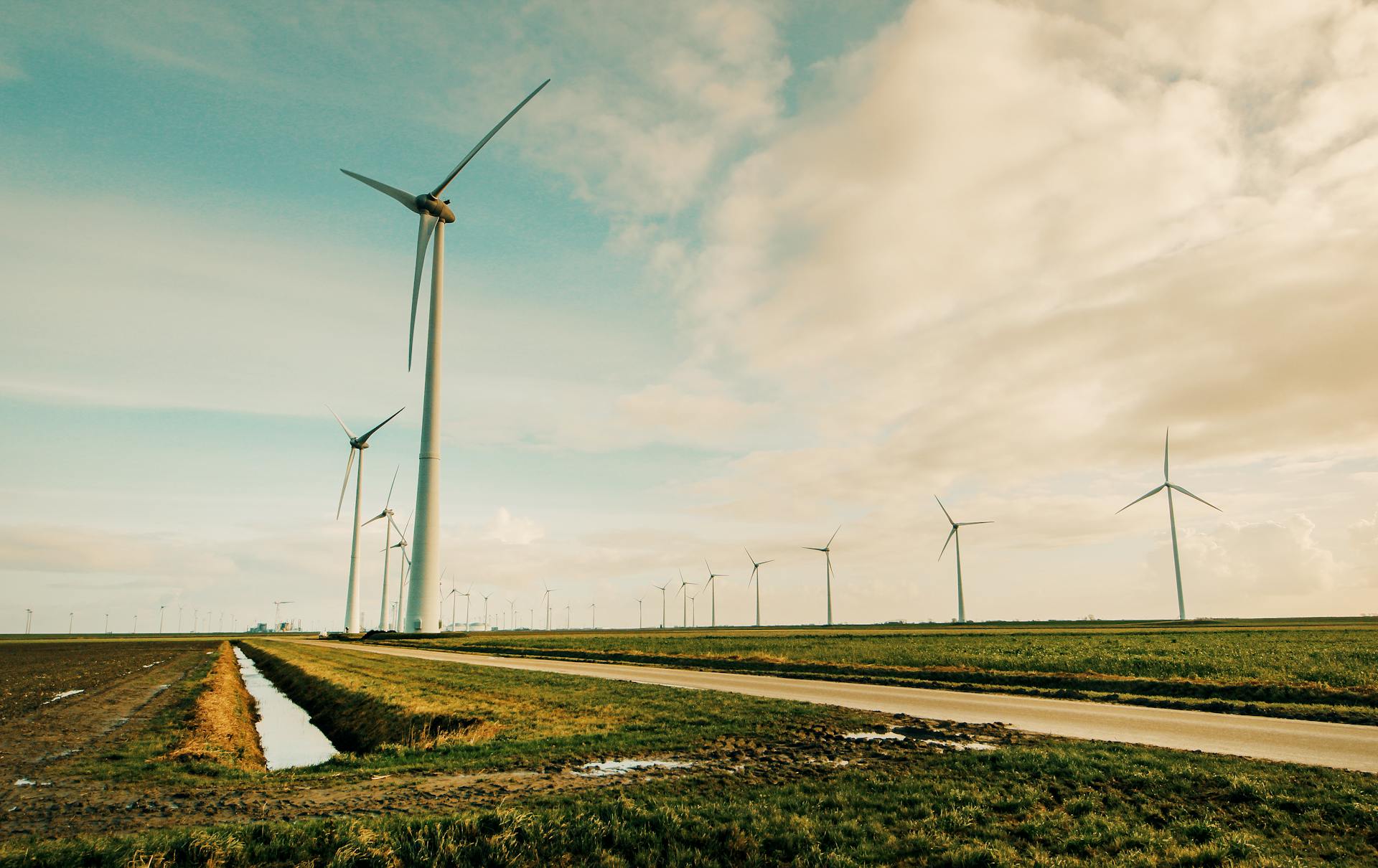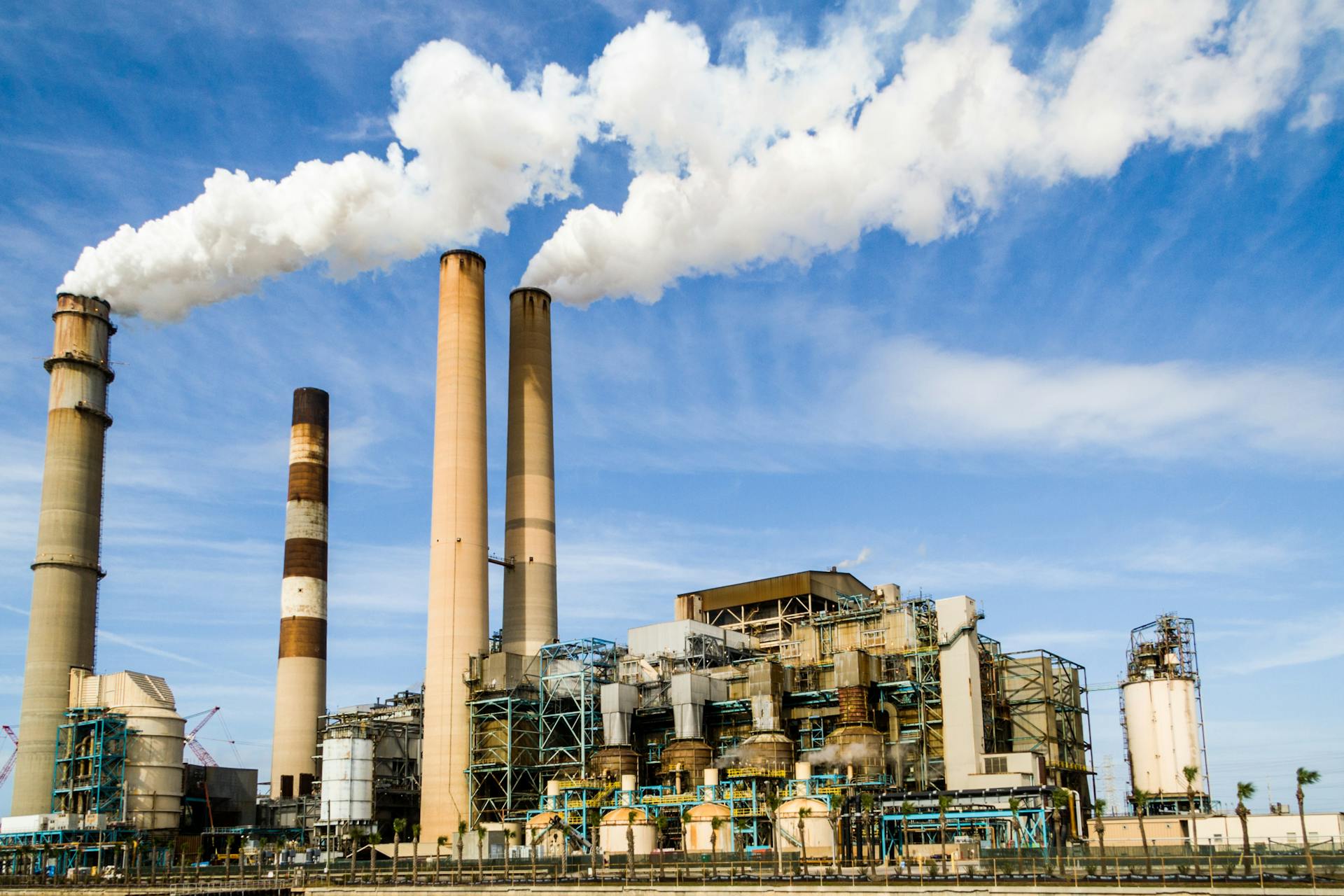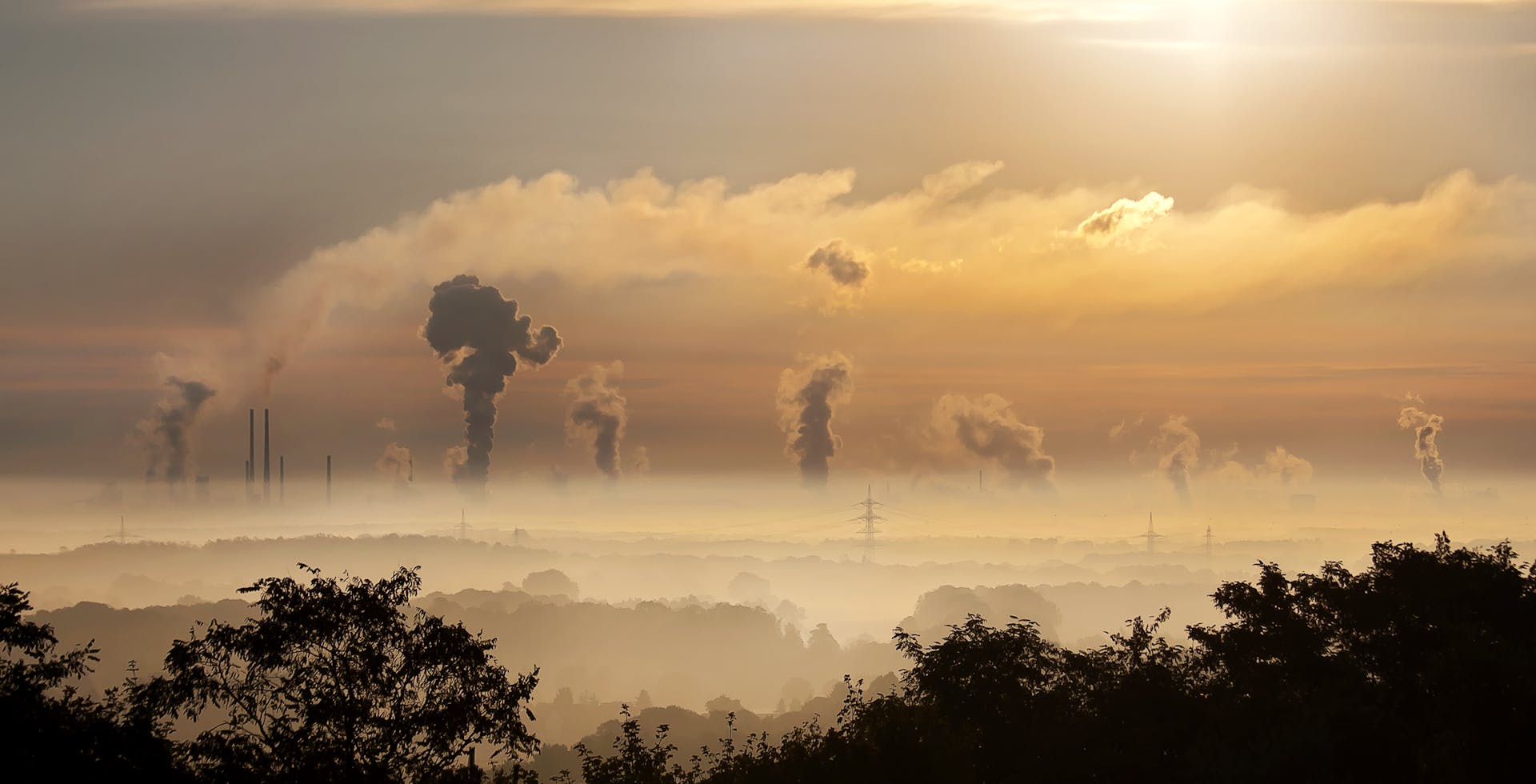
The carbon credit market is a fascinating system that helps reduce greenhouse gas emissions. It's based on the idea that companies can buy and sell credits to offset their emissions.
These credits are generated by projects that reduce emissions, such as wind farms or reforestation efforts. One credit is equal to one ton of CO2 equivalent emissions.
The market is global, with countries like China, the US, and the EU participating. Companies like Microsoft and Walmart have already invested in carbon credits to reduce their environmental footprint.
The carbon credit market is a way for companies to balance their emissions, and it's growing rapidly.
Discover more: Carbon Credits
What Are Carbon Credits?
Carbon credits are permits that allow the owner to emit a certain amount of carbon dioxide or other greenhouse gases (GHGs). One credit allows the emission of one ton of carbon dioxide or the equivalent of other greenhouse gases.
The ultimate goal of the carbon credit system is to reduce the emission of GHGs into the atmosphere. This is achieved by creating a market where companies can buy and sell credits, encouraging them to reduce their emissions.
See what others are reading: How to Trade Carbon Credits
A carbon credit represents a reduction of 1 metric ton in greenhouse gas emissions to compensate for 1 metric ton of emissions made somewhere else. This is known as a "carbon offset."
Carbon credits are essentially permits that allow the purchaser to emit a certain amount of carbon dioxide or other greenhouse gases. They can be bought, sold, or traded before being "retired", meaning they cannot be traded again.
Here are some key facts about carbon credits:
Carbon credits are also known as carbon allowances. They are a key component of the carbon credit market, which aims to reduce greenhouse gas emissions.
How Carbon Credits Work
Carbon credits are a key component of the carbon credit market. Each credit is equal to one metric ton of carbon dioxide.
Governments allow companies to emit a set amount of greenhouse gases (GHGs) before needing to purchase credits. This system is commonly called a cap-and-trade program.
For another approach, see: Trade Carbon Credits
Countries, including the United States, issue and monitor their own carbon credit status annually. The United Nations allows countries a certain number of credits, and each nation is responsible for reporting its carbon credit status annually.
Here's a simplified breakdown of the process:
- Entities, such as companies, receive a certain number of carbon credits based on their emissions limits.
- If they emit more than their allowed amount, they must purchase additional credits.
- Excess credits can be sold on a carbon exchange or marketplace.
The carbon credit market is a global system, with countries and companies participating worldwide.
How They Work?
Carbon credits are created when entities reduce or remove carbon dioxide, and each credit is equal to one metric ton of carbon dioxide. This can be done through initiatives like adding solar panels or building a wind farm, or through projects that remove and store carbon dioxide, such as reforestation or sophisticated carbon capture technology.
In a cap-and-trade program, governments or groups of governments cap emissions at certain levels and assign limits to participants, such as countries or companies. If an entity doesn't use all of its carbon credits, it can sell them to one that expects to exceed its limits.
A unique perspective: Class B Shares Private Company
Entities can buy or sell carbon credits on a carbon exchange or marketplace, where they can also sell excess credits if they've purchased too many. The United Nations allows countries to issue, monitor, and report their carbon credit status annually.
Governments allow companies to emit a set amount of greenhouse gases before needing to purchase credits. If emissions exceed limits, they are required to buy credits.
In the United States, 13 states have adopted cap-and-trade programs to reduce greenhouse gases, with 11 of them participating in the Regional Greenhouse Gas Initiative.
Worth a look: H B L Power Share Price
Do They Work?
Carbon credit systems can be effective in reducing emissions, but they're not a silver bullet. A 2017 analysis by MIT and Harvard University professors found that well-designed cap-and-trade systems can achieve their core objective of meeting targeted emissions reductions cost-effectively.
The devil is in the details, and the design of these systems is crucial. A poorly designed system can lead to inefficiencies and ineffectiveness.
Overall, these programs are not sufficient to address the problem of climate change on their own.
Recommended read: Bhp Billiton Stock Symbol
U.S. Carbon Credit Market
The U.S. Carbon Credit Market has made significant strides in reducing greenhouse gases.
Thirteen states have adopted market-based approaches to reducing greenhouse gases.
These states have come together to form programs like the Regional Greenhouse Gas Initiative (RGGI), which aims to reduce emissions through a cap-and-trade system.
The U.S. Clean Air Act of 1990 was a landmark legislation that regulated airborne emissions and is considered the world's first cap-and-trade program.
It's credited with substantially reducing emissions of sulfur dioxide from coal-fired power plants, which were a major cause of acid rain in the 1980s.
If this caught your attention, see: Trade Futures Contracts
U.S. Credits
The U.S. carbon credit market is a complex and evolving landscape, but there are some key facts to keep in mind. Thirteen states in the U.S. have adopted cap-and-trade programs to reduce greenhouse gases.
These programs include the Regional Greenhouse Gas Initiative (RGGI), which involves eleven Northeast states working together to address the issue. The Inflation Reduction Act, signed into law in 2022, also aims to reduce carbon emissions.
The Act rewards companies that store greenhouse gases underground or use them to build other products with increased tax credits. These credits have grown from $50 to $85 per metric ton of captured carbon stored underground.
Companies that use captured carbon in manufacturing processes or for oil recovery can also receive increased credits, up to $60 per ton. This is a significant increase from the previous tax incentive, known as 45Q, which was criticized for being too low to encourage investment in carbon capture projects.
For your interest: Asset Management Firm Meaning
U.S. Clean Air Act
The U.S. Clean Air Act is a crucial piece of legislation that has been regulating airborne emissions since 1990. It's often credited as the world's first cap-and-trade program, with a unique twist - it calls its emission limits "allowances" rather than traditional caps.
In 1990, the U.S. Clean Air Act was passed, paving the way for a cleaner environment. This landmark legislation has made a significant impact on reducing emissions.
The Environmental Defense Fund credits the U.S. Clean Air Act with substantially reducing emissions of sulfur dioxide from coal-fired power plants, a major contributor to acid rain in the 1980s.
Center for American Progress
The Center for American Progress has some concerns about the effectiveness of carbon credits.
In 2022, the organization noted that many offsets simply do not achieve the results they claim.
Carbon credits may serve as a convenient way for businesses to claim climate friendliness while avoiding real reductions in their carbon footprints.
California's Cap-and-Trade Program
California's Cap-and-Trade Program is a notable example of a cap-and-trade system, which is sometimes described as a market system. It was initiated in 2013.
The program applies to large electric power plants, industrial plants, and fuel distributors in the state. It's the fourth largest in the world, following those of the European Union, South Korea, and China.
The state claims its program is effective in reducing emissions, but opponents argue that it creates an excess of circulating carbon credits.
For another approach, see: Sweat Equity Programs
Who Can Participate
Businesses and governments can sell carbon credits, but anyone can buy them on the voluntary carbon market.
Carbon credits can be resold on the regulated carbon credit market, but only governments can sell them initially to businesses.
A diverse range of enterprises can sell carbon offsets on the voluntary carbon credit market, including organizations and individuals.
Landowners can sell carbon credits if they enroll their land into a project, such as reforestation or aforestation, and use the funds to pay for their operations.
You can purchase carbon offsets on the voluntary carbon credit market to fund green projects, but you can't buy carbon credits on this market.
For more insights, see: Voluntary Carbon Credit Market
Why Companies Buy
Companies buy carbon credits to legally emit more greenhouse gases (GHGs). They also purchase carbon offsets, which allow them to have a net-zero carbon emission rate.
Carbon credits are a way for companies to offset their emissions. This is done by funding emission-reduction activities, such as tree-planting or nature conservation.
There's growing public and institutional pressure for companies to make net-zero commitments. This is due to the urgency of the climate crisis.
Broaden your view: Liquid Net Worth
Some companies can reduce their emissions through changes in business practices. However, a wholesale elimination of emissions isn't feasible for many firms.
Companies buy carbon credits to meet their emissions targets. By purchasing credits, they can offset their emissions and maintain a net-zero carbon emission rate.
Here are some key reasons why companies buy carbon credits:
- Legally emit more GHGs
- Purchase carbon offsets for a net-zero carbon emission rate
- Meet emissions targets
Worldwide Initiatives
The worldwide carbon credit initiatives have been a major focus in recent years. The United Nations' Intergovernmental Panel on Climate Change (IPCC) developed a carbon credit proposal in 1997, known as the Kyoto Protocol.
The Kyoto Protocol divided countries into industrialized and developing economies, with industrialized countries operating in their own emissions trading market. This market allowed countries to sell their surplus credits to others.
The protocol also established the Clean Development Mechanism for developing countries, which issued Certified Emission Reduction (CER) carbon credits. These credits supported sustainable development initiatives.
Revenue from carbon projects funds social, educational, and health programs in forest communities. This helps support sustainable and economically resilient jobs for millions.
The Kyoto Protocol was revised in 2012 in an agreement known as the Doha Amendment, which was ratified as of October 2020. A total of 147 member nations had deposited their instrument of acceptance.
Explore further: Malaysia Development Bank
Money Distribution and Benefits
Carbon credits can be sold on the carbon credit market to other companies, with the money going to the company that sold the credit.
Money spent on carbon offsets goes directly to the project or entity sponsoring the carbon offset, which represents one ton of emissions countered by the project's operations.
Carbon markets put a price tag on greenhouse gas emissions, rewarding nations and businesses that reduce their emissions over time, and creating financial disincentives for those that emit more than their share.
The World Bank explains that carbon markets help mobilize resources and reduce costs to give countries and companies the space to smooth the low-carbon transition.
Carbon credits create a monetary incentive for companies to reduce their carbon emissions, and those that can't easily reduce emissions can still operate but at a higher financial cost.
Intriguing read: Project Finance Model
Money Distribution
Carbon credit money goes to the company that sold the credit on the carbon credit market.

The company receives the money from selling excess carbon credits to other companies.
Money spent on carbon offsets goes to the project or entity sponsoring the carbon offset.
Carbon credits create a monetary incentive for companies to reduce their carbon emissions, making it a more expensive option for those that can't easily reduce emissions.
Those that can't easily reduce emissions can still operate, but at a higher financial cost due to the higher price of carbon credits.
Carbon credits lead to measurable, verifiable emission reductions, according to proponents of the system.
If this caught your attention, see: Stock Price of L&t Finance Holdings
Making Money
Making money from carbon trading is a possibility, but it's not for the faint of heart. The market can be unpredictable and average investors may find themselves competing against more experienced professionals.
Carbon credits create a monetary incentive for companies to reduce their carbon emissions, and those that can't easily reduce emissions can still operate but at a higher financial cost. This leads to measurable, verifiable emission reductions.
Readers also liked: Emissions Reduction Currency Systems

Voluntary carbon credits are largely unregulated and notoriously lacking in transparency, which makes them a risky investment. Companies and governments can utilize carbon accounting to measure their emissions and impact.
Carbon markets put a price tag on greenhouse gas emissions, rewarding nations and businesses that reduce their emissions over time. This creates financial disincentives for those that emit more than their share.
Criticism and Challenges
Criticism of carbon markets is mounting, with both the left and right having valid concerns. Critics on the right argue that mandatory programs interfere with business and cost jobs.
Critics on the left argue that carbon markets aren't doing enough to address global warming and climate change. Voluntary credits are particularly criticized, with some studies pointing to systemic problems.
Two high-profile studies in 2023 highlighted issues with credits generated from nature-based projects. A report by TheGuardian, Die Zeit, and SourceMaterial found that over 90% of Verra-certified forestry credits didn't represent real emissions reductions.
Systemic problems with offsets are nothing new, but they're now compounded by companies' growing concern over reputational risks. This is partly due to the increasing scrutiny of ESG funds, which have faced criticism for prioritizing environmental goals over investor returns.
The potential legal ramifications of using carbon credits are also growing, with a class-action lawsuit filed in California against Delta Air Lines in May 2023. This is part of a growing trend, with 81 "climate washing" cases filed globally between 2015 and 2022.
Criticism
Criticism of carbon markets is widespread, with both the right and left sides of the political spectrum having valid concerns. Critics on the right argue that mandatory programs interfere with business and cost jobs.
Voluntary credits are particularly contentious, with over 90 percent of forestry credits certified by Verra not representing real emissions reductions. This is according to a report done by TheGuardian, Die Zeit, and SourceMaterial in January 2023.

Companies are increasingly sensitive to potential reputational risks over net-zero strategies, which is why two high-profile studies in January and August 2023 pointed to systemic problems with credits generated from nature-based projects. This has led to a decline in the trade of credits.
A class-action lawsuit was filed in California in May 2023 against Delta Air Lines, arguing that the airline misrepresented itself as carbon neutral based on problematic carbon offsets. This is part of a growing trend of "climate washing" cases filed against companies globally.
The lack of standardization in contracts and multiple independent standard organizations using different methodologies to certify projects and credits complicates efforts to certify projects and prevent buyers from clear views on the quality of different credits. This heterogeneity is a significant challenge in the voluntary carbon market.
A fresh viewpoint: Aircraft Leasing Companies
What Are Not
Carbon credits are often misunderstood, and it's essential to clear up some common misconceptions. Carbon credits are not a "license to pollute", as they're meant to be a tool for companies working to reduce their emissions, not a pass for business as usual.

Companies that invest in nature-based credits are actually leaders, not laggards. Research has shown that companies that bought voluntary carbon credits did more to cut emissions than those that didn't.
Carbon projects alone won't solve climate change – they're a vital way to flatten the carbon curve while the world transitions away from fossil fuels. This is not a silver bullet, but rather a crucial step in the right direction.
Carbon projects have been implemented for over two decades, and through testing and scientific advancements, they've become a common practice. Despite what some might claim, carbon projects are not doomed by technical challenges.
It's also a misconception that high-quality carbon projects are a "land grab." In reality, these projects are built on the free, prior, and informed consent of local communities in the project area.
Frequently Asked Questions
How much is a carbon credit worth?
A carbon credit is typically worth between $30-$50 in 2023, depending on its quality and risk level. Higher-quality credits with lower risk are generally more valuable than lower-quality ones.
Sources
- https://www.investopedia.com/terms/c/carbon_credit.asp
- https://www.unep.org/topics/climate-action/climate-finance/carbon-markets
- https://www.investopedia.com/carbon-markets-7972128
- https://www.conservation.org/projects/what-are-carbon-credits
- https://www.csis.org/analysis/whats-plaguing-voluntary-carbon-markets
Featured Images: pexels.com


